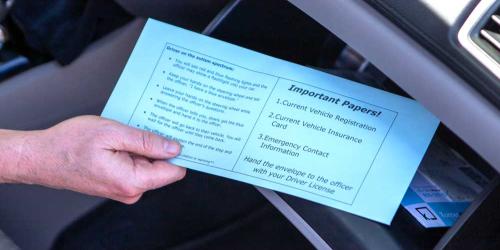The Blue Envelope Program is for Vermont drivers on the autism spectrum. It aims to make routine traffic stop interactions easier. Similar programs exist in Massachusetts and Arizona. Vermont’s Blue Envelope program emerged from these two other state programs. We worked with the University of Vermont Autism Collaborative to develop this program. The Blue Envelope Program helps make traffic stops safer and less stressful for autistic drivers.
Here, you can find tips for drivers on the autism spectrum. You can also find tips for law enforcement interacting with drivers on the autism spectrum.
It is simply a blue envelope designed to hold your important driver’s documents:
- A photocopy of your Driver’s License
- Registration
- Proof of insurance
- Support person contacts
However, its significance goes beyond just a storage solution. The blue envelope alerts the law enforcement officer that the driver is a person who is autistic. Instructions on the envelope help the officer adapt their approach.
The Blue Envelope Program has four main goals:
- Enhancing Understanding: Officers have access to information about autism on the envelope. This information aims to promote empathy and patience with the desired outcome of more positive interactions.
- Reducing Anxiety: Traffic stops can be more stressful for autistic people. The Blue Envelope is a visual cue that helps officers adjust their communication, which may help reduce the driver's anxiety.
- Streamlining Communication: The envelope has practical tips for officers. These tips may make interactions easier for people on the autism spectrum. This is important in high-stress situations like traffic stops.
- Encouraging Preparedness: The Blue Envelope is a tool that may help autistic drivers be prepared and more confident and secure for a traffic stop by:
- Having all their documents in one place
- Knowing how to present the envelope during a stop
The Blue Envelope is more than just an envelope. The Blue Envelope is a symbol of our commitment to inclusivity and understanding. It is a step forward to see that every driver, regardless of their neurological differences, should feel safe and respected on the road. Through this program, we aim to build bridges between law enforcement and the autism community. We hope to foster a culture of awareness and compassion that benefits everyone involved.
TABLE OF CONTENTS
- Getting Your Blue Envelope
- How Your Blue Envelope Will be Used
- Preparing Your Envelope
- Tips for a Safe Traffic Stop
Getting Your Blue Envelope
The Blue Envelope is free and easy to participate in. You do not need to produce medical records or register for the program. No one will know you are participating in the Blue Envelope program unless you tell them.
To request a Blue Envelope, you may either:
- Visit any DMV location to request one in person or
- Complete our online form to have an envelope mailed to you
How Your Blue Envelope Will Be Used
Use your Blue Envelope only during traffic stops. Tell the officer you have a Blue Envelope and hand it to them when requested. The officer may take your documents back to their squad car during the stop. Your documents will remain secure while the officer has them. The officer will return your Blue Envelope and its documents to you at the end of the traffic stop. At no other time will the DMV or law enforcement have access to your information as a part of this program.
Preparing Your Envelope
Once you have your Blue Envelope, the next step is to prepare it properly to ensure it serves its intended purpose during a traffic stop. This preparation involves placing the right documents inside and knowing where to keep the envelope in your vehicle for easy access. Here’s how to get your envelope ready:
-
Gather Your Documents: Collect the following documents:
- Photocopy of your current Driver's License
- Vehicle Registration
- Proof of Insurance
-
Place Documents Inside: Fold your documents to fit into the Blue Envelope. Insert your documents into the envelope. The envelope is designed to keep your documents secure and accessible when you need them.
-
Identify a support person and add their contact information to the Blue Envelope.
-
A support person can be anybody who might be easily reached by the police officer.
-
Talk to your support person about the Blue Envelope and provide them with a copy of this information.
-
-
Add any other important information about yourself on the envelope.
- Ease of Access: Consider attaching the Blue Envelope to your driver's side sun visor. You can store it in any other accessible and visible location. You want the envelope within easy reach if you need to find your documents quickly. If the envelope is visible, it can be noticed by law enforcement. The officer then knows to adjust their communications for the driver with autism.
-
Inform Other Drivers: If you share your vehicle with family or friends, tell them about the Blue Envelope Program. Anyone driving your vehicle should know about the Blue Envelope and where to find important documents.
-
Keep your documents current: Make sure to replace any documents in the Blue Envelope when they get updated. Keeping your information up-to-date helps your traffic stop go smoothly.
Having your Blue Envelope set up properly helps ensure a smooth traffic stop interaction. This helps reduce driver stress. It also helps officers recognize autistic drivers and adapt their approach. The Blue Envelope Program helps accommodate the needs of drivers on the autism spectrum. Having your Blue Envelope ready to go creates a safer and more understanding driving experience for everyone on the road.
Remember, the Blue Envelope does more than hold your documents. The Blue Envelope is a communications tool designed to help officers and autistic drivers interact safely and respectfully. Having your Blue Envelope ready to go means you can use this tool whenever it's needed.
Tips for a Safe Traffic Stop
Navigating a traffic stop can be challenging for anyone, but it can be particularly stressful for individuals on the autism spectrum and for officers who wish to handle the situation with care and understanding. Here are some tips for both parties to ensure a safe and respectful traffic stop:
For Drivers on the Autism Spectrum:
-
Flashing Lights and Loud Sounds: The officer may signal you to pull over with flashing lights and a siren. They may use a loudspeaker to communicate with you. The officer may use a flashlight to look inside your car. You may also hear the officer's communications radio during the traffic stop.
-
Safety First: Always keep your hands visible and avoid making sudden movements. Inform the officer if you need to reach into your pocket or glove compartment for anything. Hand Placement: Keep your hands on the steering wheel where the officer can see them. Don't remove your hands from the wheel unless the officer tells you to. Keep your hands on the steering wheel even if the officer is not at your car.
-
Stay Calm: Try to remain as calm as possible. Deep breathing can help manage stress levels.
-
Use Your Blue Envelope: When the officer approaches your car, say, "I have a Blue Envelope." Keep your Blue Envelope in an easily accessible, visible place like the sun visor. When the officer tells you, slowly get the Blue Envelope. If the officer is unaware of the purpose of the Blue Envelope, politely request that they scan the QR code to learn more.
-
Follow Instructions: Listen to the officer’s instructions and try to follow them as best you can. If you are confused, it's okay to ask the officer to clarify.
-
Support Person Contact: You may feel overwhelmed or unable to communicate well. If this happens, you can ask the officer to contact your support person.
-
Waiting: When the officer returns to their cruiser, you will need to wait in your car for them until they come back. You may need to wait up to 10-15 minutes. When the officer returns, they will explain the end of the stop and tell you when to leave. They will return the Blue Envelope and its documents to you.
For Law Enforcement Officers:
-
Recognize the Blue Envelope: The Blue Envelope signals that the driver is on the autism spectrum. Note the communication tips provided on the envelope.
-
Exercise Patience: Understand that the individual may need more time to process information and respond. Avoid rushing them.
-
Clear Communication: Use simple, direct language and give one instruction at a time. Avoid idioms or phrases that might be misunderstood. Allow drivers extra time to respond as they may need more time to process what you are saying and formulate their response. Clearly tell the driver when the stop ends and that they may leave.
-
Be Observant: Pay attention to non-verbal cues indicating the driver is feeling overwhelmed or stressed. Drivers may exhibit signs of high anxiety. Bright lights and loud sounds can be overwhelming for autistic people. Individuals on the autism spectrum may display repetitive body movements or fidgeting and may not make eye contact. Additionally, they may exhibit unique speech patterns or be unable to speak, especially under stress. Autistic people may show emotions differently. If they appear upset or frustrated, it does not mean they intend to be aggressive toward you.
-
De-escalate When Necessary: If you notice signs of distress, consider ways to de-escalate the situation, such as reducing sensory inputs (e.g., turning off sirens or speaking calmly). If the driver appears to be struggling, consider contacting their support person listed as the Blue Envelope.
Creating a Positive Outcome
These tips help create positive traffic stops for both autistic drivers and officers. The Blue Envelope Program adapts traditional procedures to the needs of autistic community members. The goal is a traffic stop that is safe, respectful, and positive for everyone involved.
Remember, the goal of the Blue Envelope program is not just to make traffic stops go more smoothly. The Blue Envelope program helps autistic drivers have a greater sense of security and confidence. It helps law enforcement officers adapt to drivers who may have different needs. This enhances officers' ability to serve and protect all individuals in the community.
We can all contribute to making our roads safer and more inclusive through awareness, preparation, and empathy.



